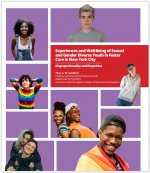
Experiences and Well-Being of Sexual and Gender Diverse Youth in Foster Care in New York City
Omschrijving
This is the first survey to report on the proportion of youth in foster care in New York City who are LGBTQAI+ and differences in their experiences compared to those of youth who are not LGBTQAI+.
The acronym LGBTQAI+ comprises persons who because of their gender and sexuality have specific needs and are treated differently than other persons, which might negatively affect their well-being. The letters stand for lesbian, gay, bisexual, transgender, queer or questioning, agender or asexual, and intersex. This survey was commissioned by the New York City Administration for Children's Services (ACS), which is committed to serving youth in foster care that are LGBTQAI+. The survey was implemented with generous support from the Annie E. Casey Foundation, the Redlich Horwitz Foundation, and the NYC Unity Project. This report provides the detailed findings from this survey.A separate document LGBTQ+ Action Plan produced by ACS identifies the steps taken to date to provide services and supports to LGBTQAI+ youth and plans to move forward in response to the survey findings. According to the survey: LGBTQAI+ youth are overrepresented in foster care. More than one out of three youths (34.1%), ages 13-20, in New York City foster care is LGBTQAI+. This is substantially higher than the proportion of LGBTQAI+ youth in the general population. LGBTQAI+ youth in foster care are more frequently youth of color.
With almost three quarters of the sample identifying as African American and almost a third identifying as Latinx,the sample reflects the population of New York City youth in foster care, in which people of color are disproportionally represented. Within this already racially and ethnically disproportionate group, LGBTQAI+ youth are less likely to be white and more likely to be Latinx. The placements of LGBTQAI+ youth in foster care differ from those of non-LGBTQAI+ youth in foster care. Compared to non-LGBTQAI+ youth, LGBTQAI+ youth were more likely to be placed in group homes or residential care and less likely to be placed in family-based care. LGBTQAI+ youth were less satisfied with their current placement. LGBTQAI+ youth were more likely to say that they experienced little to no control over their lives in foster care and to have heard staff or other people refer to them as “hard to place.” The family experiences of LGBTQAI+ youth in foster care can be challenging. While LGBTQAI+ youth were more likely to be in touch with family members, they saw these family members less frequently. Furthermore, LGBTQAI+ youth experienced family members as less supportive than non-LGBTQAI+ youth did. Fewer LGBTQAI+ youth reported that there were adults in their lives, other than family members, who they could rely on and by whom they felt supported.
LGBTQAI+ young people have more struggles with institutional systems and higher risk factors for depression. LGBTQAI+ youth had been absent without permission from their foster care placements for significantly more days than non-LGBTQAI+ youth; they also were more likely to have been homeless and to have had negative confrontations with the police. In addition, LGBTQAI+ youth were more likely to have been criticized for behaving and for dressing too much like the other sex. These risk factors were associated with differences in well-being: LGBTQAI+ youth reported to experience more depressive symptoms and fewer feelings of optimism compared to non-LGBTQAI+ youth.
